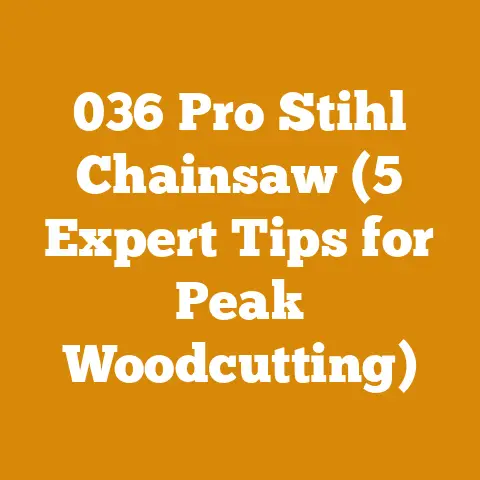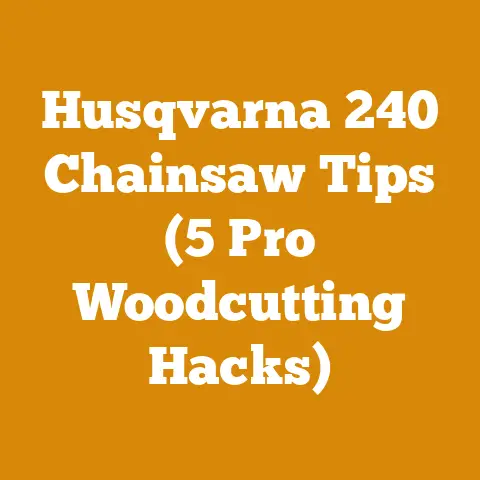Chainsaw Chain Catcher: Essential Safety Gear (5 Pro Tips)
The ground vibrated beneath my boots, the air thick with the scent of pine and sawdust. I was deep in the Oregon woods, felling a particularly stubborn Douglas fir. The chainsaw roared, biting into the wood, when suddenly – SNAP! The chain, protesting its workload, let loose, whipping back towards me like a metal serpent. My heart leaped into my throat. I instinctively ducked, expecting the worst. But then, a solid thunk. The chain catcher, a small piece of unassuming plastic, had done its job, stopping the runaway chain just inches from my leg. That day, I understood the true value of this often-overlooked piece of safety equipment.
In this article, I’m going to delve deep into the world of chainsaw chain catchers. We’ll explore why they are absolutely essential safety gear, and I’ll share five pro tips to ensure yours is always ready to protect you. This isn’t just about avoiding injury; it’s about working smarter, safer, and more efficiently in the woods.
Key Takeaways:
- Chain catchers are vital for operator safety, preventing serious injuries from broken or derailed chainsaw chains.
- Regular inspection and maintenance of the chain catcher are crucial for its effectiveness.
- Understanding different types of chain catchers helps you choose the right one for your chainsaw and cutting needs.
- Proper chainsaw maintenance reduces the likelihood of chain breaks and derailments, making the chain catcher’s job easier.
- Knowing how to react in the event of a chain break or derailment can minimize potential harm.
Chainsaw Chain Catcher: Essential Safety Gear (5 Pro Tips)
What is a Chainsaw Chain Catcher and Why Do You Need One?
A chainsaw chain catcher is a small, often overlooked, but incredibly important safety device on your chainsaw. It’s typically a small piece of metal or, more commonly, high-impact plastic located near the inside of the chainsaw bar, just behind the clutch. Its sole purpose is to catch a broken or derailed chain, preventing it from flying back towards the operator.
Think of it like this: a chainsaw chain travels at incredibly high speeds. If it breaks or comes off the bar while you’re cutting, it can become a dangerous projectile. Without a chain catcher, that chain could whip back and cause serious injury to your hands, arms, legs, or even your face.
Data Point: According to the Consumer Product Safety Commission (CPSC), chainsaw-related injuries result in tens of thousands of emergency room visits each year in the United States alone. While not all injuries are caused by chain breaks, a significant portion could be prevented or mitigated by a properly functioning chain catcher.
My Experience: I once witnessed a seasoned logger, a man I deeply respected, suffer a nasty gash to his forearm when a chain snapped and his chain catcher failed. It was a harsh reminder that even the most experienced professionals aren’t immune to accidents, and that safety gear, like a functional chain catcher, is non-negotiable.
Pro Tip #1: Regular Inspection and Maintenance – Your First Line of Defense
The most crucial step in ensuring your chain catcher is effective is regular inspection and maintenance. This isn’t a “set it and forget it” kind of thing. You need to make it a routine part of your chainsaw maintenance schedule.
Here’s what I recommend:
- Before each use: Visually inspect the chain catcher for any cracks, breaks, or signs of damage. Look for wear around the edges, especially where the chain would make contact.
- After each use: Clean the chain catcher with a brush or compressed air to remove sawdust, debris, and oil. This ensures it can move freely and engage properly.
- Periodically (every 25 hours of use or monthly): Check the chain catcher’s mounting hardware. Make sure it’s securely attached to the chainsaw body. Tighten any loose screws or bolts. If your chain catcher is adjustable, ensure it’s properly positioned according to the manufacturer’s instructions.
- Replacement: If you find any damage to the chain catcher, replace it immediately. A cracked or broken chain catcher is essentially useless. Don’t risk it.
Why is this important? Over time, chain catchers can become brittle from exposure to sunlight, oil, and vibrations. They can also be damaged by impacts with logs or other objects. Regular inspection allows you to identify potential problems before they lead to a failure.
Expert Insight: “The chain catcher is often the most neglected part on a chainsaw,” says Mark Johnson, a certified chainsaw technician with over 20 years of experience. “People assume it’s just there and will always work. But like any other part, it needs regular attention to ensure it’s ready when you need it.”
Pro Tip #2: Understanding Different Types of Chain Catchers
Not all chain catchers are created equal. There are different designs, materials, and features to consider. Understanding these differences can help you choose the right chain catcher for your chainsaw and your cutting needs.
Common Types:
- Fixed Chain Catchers: These are the most common type, typically made of plastic or metal. They are permanently mounted to the chainsaw body and don’t have any moving parts.
- Adjustable Chain Catchers: These chain catchers allow you to adjust their position to accommodate different bar lengths or chain tensions. This can be useful if you frequently switch between different cutting setups.
- Metal Chain Catchers: Metal chain catchers are generally more durable than plastic ones, but they can also be more expensive. They are often found on professional-grade chainsaws.
- Plastic Chain Catchers: Plastic chain catchers are more common on homeowner-grade chainsaws. They are lighter and less expensive than metal ones, but they may not be as durable.
Choosing the Right One:
- Consider your chainsaw model: Not all chain catchers are compatible with all chainsaws. Check your owner’s manual or consult with a chainsaw dealer to ensure you choose the correct replacement.
- Think about your cutting needs: If you do a lot of heavy-duty cutting, a metal chain catcher may be a better choice. If you only use your chainsaw occasionally for light tasks, a plastic chain catcher may be sufficient.
- Read reviews: See what other users have to say about different chain catcher models. This can give you valuable insights into their durability and performance.
My Recommendation: I personally prefer adjustable chain catchers, especially if I’m using different bar lengths on the same saw. It gives me that extra level of assurance that the chain catcher is positioned perfectly.
Pro Tip #3: Proper Chainsaw Maintenance – Preventing Chain Breaks in the First Place
While the chain catcher is there to protect you in the event of a chain break, the best defense is to prevent chain breaks from happening in the first place. Proper chainsaw maintenance is key to extending the life of your chain and reducing the risk of accidents.
Essential Maintenance Practices:
- Sharpen your chain regularly: A dull chain puts more stress on the chainsaw and increases the likelihood of a chain break. Learn how to sharpen your chain properly or take it to a professional.
- Maintain proper chain tension: A chain that is too loose can derail easily, while a chain that is too tight can overheat and break. Check your chain tension before each use and adjust as needed.
- Lubricate your chain: Proper chain lubrication reduces friction and wear, extending the life of your chain. Use a high-quality bar and chain oil and check the oil level frequently.
- Clean your chainsaw: Regularly clean your chainsaw to remove sawdust, debris, and oil. This helps prevent overheating and ensures that all parts are functioning properly.
- Inspect your chain: Before each use, inspect your chain for any signs of damage, such as cracks, worn links, or missing teeth. Replace the chain if you find any damage.
Data Point: Studies have shown that properly maintained chainsaws experience significantly fewer chain breaks and derailments than those that are neglected. Regular chain sharpening alone can reduce the risk of chain breaks by as much as 50%.
My Approach: I’m meticulous about my chainsaw maintenance. I sharpen my chain after every tank of gas, check the chain tension religiously, and clean my saw thoroughly after each use. It might seem like overkill to some, but I’ve found that it pays off in the long run with increased safety and reduced downtime.
Pro Tip #4: Knowing How to React – Minimizing Potential Harm
Even with a properly functioning chain catcher and diligent maintenance, chain breaks can still happen. Knowing how to react in the event of a chain break can minimize potential harm.
Immediate Actions:
- Stop the saw immediately: As soon as you feel or hear a chain break, release the throttle and engage the chain brake.
- Maintain your grip: Don’t let go of the chainsaw. A runaway chainsaw can cause serious damage.
- Step back: Take a step back from the cutting area to avoid being struck by the broken chain or any flying debris.
- Assess the situation: Once the saw has stopped, carefully inspect the damage and determine the cause of the chain break.
Preventative Measures:
- Wear appropriate safety gear: Always wear a helmet with a face shield, eye protection, hearing protection, gloves, chainsaw chaps, and steel-toed boots when operating a chainsaw. This gear can help protect you from injury in the event of a chain break.
- Maintain a safe working distance: Keep a safe distance from other people when operating a chainsaw. This reduces the risk of injury to bystanders in the event of a chain break.
- Be aware of your surroundings: Pay attention to your surroundings and be aware of any potential hazards, such as trees, rocks, or power lines.
- Don’t work alone: If possible, work with a partner when operating a chainsaw. This way, someone can assist you in the event of an accident.
Quote: “Knowing how to react to a chain break is just as important as having a functional chain catcher,” says Sarah Thompson, a certified safety instructor with the Forest Resources Association. “Practice your emergency procedures so that you can react quickly and effectively in a real-world situation.”
My Personal Practice: I regularly practice my emergency stop procedure. I’ll simulate a chain break and practice engaging the chain brake and stepping back from the cutting area. It might seem silly, but it helps me build muscle memory so that I can react instinctively in a real emergency.
Why Quality Matters:
- Reliability: High-quality replacement parts are more reliable and less likely to fail. This is especially important for safety equipment like chain catchers.
- Durability: Quality parts are made from durable materials that can withstand the rigors of chainsaw use.
- Fit: Genuine or reputable aftermarket parts are designed to fit your chainsaw perfectly, ensuring proper function and safety.
- Warranty: Many quality parts come with a warranty, giving you peace of mind knowing that you’re covered in case of defects.
Where to Buy:
- Authorized Dealers: The best place to buy replacement parts is from an authorized dealer for your chainsaw brand. They will have genuine parts that are guaranteed to fit and function properly.
- Reputable Aftermarket Suppliers: There are also many reputable aftermarket suppliers that offer high-quality replacement parts. Look for suppliers with a good reputation and positive customer reviews.
- Avoid Cheap Imitations: Be wary of cheap imitation parts sold online or at discount stores. These parts are often made from inferior materials and may not fit or function properly.
My Rule: I always stick with genuine parts whenever possible. Yes, they might be a little more expensive, but I consider it an investment in my safety and the longevity of my chainsaw.
Actionable Tip: Next time you need to replace your chain catcher, take the time to research different brands and suppliers. Read reviews, compare prices, and choose a quality part that you can rely on.
Conclusion: Your Chain Catcher – A Small Piece with a Big Impact
The chainsaw chain catcher is a small, often overlooked part of your chainsaw, but it plays a vital role in protecting you from serious injury. By following these five pro tips, you can ensure that your chain catcher is always ready to do its job.
Remember: Regular inspection and maintenance, understanding different types of chain catchers, proper chainsaw maintenance, knowing how to react in the event of a chain break, and choosing quality replacement parts are all essential for safe chainsaw operation.
Don’t underestimate the importance of this small piece of plastic or metal. It could be the difference between a close call and a serious injury. Take the time to inspect and maintain your chain catcher regularly, and always prioritize safety when operating a chainsaw.
Now, get out there, work hard, and stay safe! And if you’re in the market for a new chainsaw or replacement parts, remember to prioritize safety and choose quality equipment that you can rely on. Your well-being is worth it.






